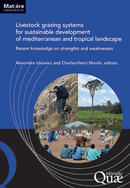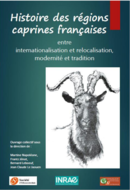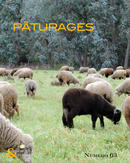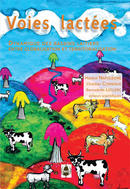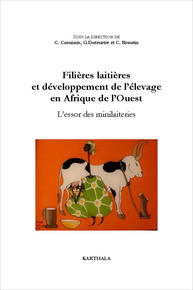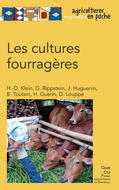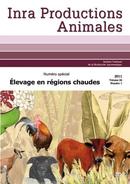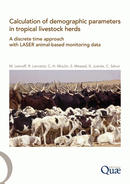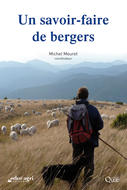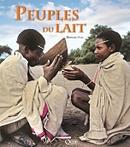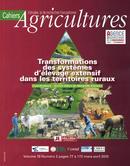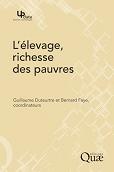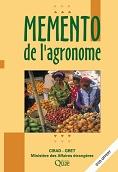Books
Last update: 19 January 2023
Livestock grazing systems and sustainable development in the Mediterranean and Tropical areas
Pasture-livestock farming may contribute to the territories’ sustainability, especially in Mediterranean and tropical areas where it is a very common practice. Analyzing this system’s adaptation capacity, efficiency and innovation potential sheds light on its major strengths as well as on its need for support.
Livestock grazing systems for sustainable development of mediterranean and tropical landscape
Alexandre Ickowicz, Charles-Henri Moulin
© Edition Quae
2022
L'élevage des grands camélidés
L’ancêtre des grands camélidés, originaire d’Amérique du Nord, aurait migré vers l’Asie il y a plusieurs millions d’années, pour s’établir dans des zones arides : la péninsule arabique pour les dromadaires — appelés aussi chameaux d’Arabie ou chameaux à une bosse —, et l’Asie centrale pour les Bactrianes — ou chameaux à deux bosses, parfois dénommés chameaux d’Asie.
La remarquable résistance des grands camélidés à des conditions climatiques extrêmes, leurs fonctions de service (transport, monte ou gestion des espaces pastoraux), ainsi que la qualité et la bonne valorisation de leurs produits sur les marchés nationaux et internationaux (lait, viande ou laine), ont fait émerger ces dernières décennies une nouvelle filière pour ces espèces cantonnées, encore il y a peu, à la subsistance de populations nomades vivant dans les régions désertiques d’Afrique et d’Asie.
Cette filière s’implante aujourd’hui non seulement dans les pays d’origine, mais aussi dans le monde occidental dans lequel la gestion des élevages, basée sur des pratiques mises en œuvre pour l’espèce bovine, s’avère souvent inopérante. Cet ouvrage de référence, unique en langue française, s’adresse donc à tous les acteurs de la filière, qu’ils soient concernés par les activités d’élevage, de conseil technique ou de soins aux grands camélidés. Il décrit successivement les généralités sur l’espèce, les bases physiologiques de la reproduction, de la lactation et de l’alimentation, les principales productions, ainsi que la gestion de la santé et de l’hygiène en élevage camelin.
L'élevage des grands camélidés
Bernard Faye, Gaukhar Konuspayeva, Cécile Magnan
© Edition Quae
2022
Histoire des régions caprines françaises :
entre internationalisation et relocalisation, modernité et tradition
Cet ouvrage met en perspective la diversité des trajectoires singulières des régions caprines de France métropolitaine pour en découvrir des composantes communes riches d’enseignement pour l’avenir.
Une première partie retrace les grandes transformations de la France rurale, de l’agriculture et de l’élevage depuis les années 1950. Nous distinguons trois époques, la fin de la paysannerie, la modernisation mais aussi le retour à la terre dans certaines régions, et l’époque actuelle marquée par un double mouvement de globalisation des échanges et de territorialisation des activités et des produits. Ces dynamiques ne se sont pas passées de la même façon dans toutes les régions, ni aux mêmes époques. L’histoire de ces régions s’inscrit dans des contextes territoriaux marqués par des caractéristiques sociales, économiques, culturelles. Une seconde partie invite au voyage dans les principales régions caprines de France métropolitaine. Pour chaque région nous retraçons les étapes des transformations des activités caprines dans les territoires et les facteurs qui ont joués sur ces recompositions. Nous mettons l’accent sur la façon dont les dynamiques agroindustrielles et les filières longues ou au contraire de pérennisation de la production fermière et des circuits courts ont influencé (ou non) les transformations dans les régions. En partie trois, une discussion transversale aux chapitres régionaux termine l’ouvrage. Nous soulignons la double réussite d’une filière qui a su s’inscrire d’une part dans le processus d’industrialisation et d’internationalisation et d’autre part dans des dynamiques territoriales d’ancrage au terroir. Depuis 1970, la production industrielle française de fromages de chèvre a été multipliée par six (16 000 t/an en 1970 et 100 000 t/an en 2020). Dans le même temps, une production fermière et artisanale s’est maintenue, permettant la préservation de savoir-faire et de fromages de chèvre traditionnels au lait cru (15 AOP caprines en 2020). Il en résulte une diversité de modèles d’élevage, d’entreprises de transformation et plus largement de chaînes de valeur. Nous analysons les principaux facteurs qui ont concouru à diversifier la filière caprine française et des trajectoires régionales. Nous discutons d’enjeux pour le futur au regard de six questionnements en lien avec la durabilité des systèmes de production - transformation. C’est à l’interface de ces succès et questionnements, avec un pilotage qui rassemble et valorise les synergies et les talents du plus grand nombre, que se dessine l’avenir de la filière et de ses éleveurs de chèvres, qu’ils soient fermiers ou laitiers.
Mots clés : élevage caprins, filière fermière, filière laitière, fromage, territoire, bassin de production, dynamique industrielle, dynamique artisanale, transition des activités, local, global.
Histoire des régions caprines françaises : entre internationalisation et relocalisation, modernité et tradition
Ouvrage collectif sous la direction de : Martine Napoléon, Frantz Jénot, Bernard Leboeuf, Jean Claude Le Jaouen
© INRAE, ©Société d'Ethnozootechnie
ISBN 978-2-7380-1443-7
DOI: 10.17180/t528-2045
2022
Prospects for Livestock-Based Livelihoods in Africa's Drylands
Prospects for Livestock-Based Livelihoods in Africa’s Drylands examines the challenges and opportunities facing the livestock sector and the people who depend on livestock in the dryland regions of Sub-Saharan Africa. It presents a novel way of thinking about pastoral development, grounded in a conceptual framework that focuses on the multiple shocks that drylands livestock keepers face and how those shocks can be addressed, drawing on a state-of-the-art literature review carried out by scientists of leading research institutes and development organizations, and integrating the results of an innovative approach to modeling development options for the drylands livestock sector. Looking to the future, the picture is mixed. On the positive side, demand for red meat is expected to strengthen in domestic and regional markets, suggesting that livestock keepers will have good market opportunities. On the negative side, a large majority of livestock keepers are classifi ed as poor, and the natural (feed) resource base is likely to be suffi cient to enable improved meat and milk production for the growing human population. Prospects for the livestock sector through 2030 vary by aridity zone. In arid and semi-arid zones, a reasonable goal for 2030 is to have land use, training, and microfi nance systems established that promote an appropriate balance between human and livestock carrying capacities, featuring mainly grassland/pastoral systems that reliably and sustainably satisfy the minimum income needs of herder households, produce at least a signifi cant part of the demand in local markets for animal source food, and provide environmental services for which livestock keepers receive compensation. The goal includes signifi cant employment generation outside the sector. In the higher rainfall zones of the semi-arid areas, and in the subhumid zones, a reasonable goal for 2030 is to have intensifi ed production systems established, featuring mainly mixed livestock/arable farming or agro-pastoral systems that are closely linked to nearby grassland/pastoral systems and that consistently generate marketable surpluses of differentiated red meat and livestock products that can compete not only in the expanding domestic market but also in selected regional markets.
Prospects for Livestock-Based Livelihoods in Africa's Drylands
Sous la direction de Cornelis de Haan avec la participation de Christian Corniaux, Alexandre Ickowicz, Matthieu Lesnoff, Ibra Touré et Abdrahmane Wane
World Bank Studies
ISBN 978-1-4648-0836-4
2016
Composer avec les moutons : lorsque des brebis apprennent à leurs bergers à leur apprendre (Coming to terms with sheep: when sheep teach their shepherds to teach them)
If sheep have a reputation for being stupid, it's all Panurge's fault. Sheep only behave "sheep-like" when they want to and when it is in their interest to do so. There are no dumb sheep, just "poorly educated" animals. A philosopher and an ecologist have reconstructed, with a dozen shepherds, an event that is seldom talked about, namely when animals teach humans to teach them. Their objective is to understand how this learning develops. This book reveals a little-known fact: shepherds and sheep are engaged in a never-ending conversation though which they learn about and respect each other. Between them, they create coherence and cultivate the idea of the world’s potential for beauty. Sheep do even better: they realize this idea. And they do this, in particular, when they eat. Day after day, coming to terms with sheep is what shepherds learn to do. Humans and animals engage together in the creation, not only of an agreement, but also of an ethos of ways of living in the world. An art of reconstructing the fabric of sensory continuities which has suffered some rips and tears nearly everywhere. This is also what it means to come to terms with sheep.
Composer avec les moutons : lorsque des brebis apprennent à leurs bergers à leur apprendre
Vinciane Despret & Michel Meuret,
Cardère Edition, Coll. Hors les drailles. Février 2016
154 pages. €12
Mentioned in the newspaper, “Le Monde”
Pâturages - Nourrir ses bêtes et habiter le territoire (Pastures - Feeding animals and living on the land)
"Feed the world!" "Respect the environment and animal welfare!” "Pay attention to consumers’ tastes and health!” Livestock farming is subject to sometimes paradoxical social and political injunctions that globalisation is accentuating every day, and which target in particular the ways in which animals are raised and fed. "Grazing, that’s the natural way.” No, on the contrary. Far from bucolic images, an anthropologist, a geographer and a zootechnician show in this Technics&Culture issue how the oldest way of feeding animals, which livestock farmers are constantly reinterpreting, also is probably among the most complex and lively in social, economic and political terms. From Lapland to Patagonia, via the French mountains, grazing allows us to ask fresh questions about the place of livestock and livestock farmers in the contemporary world.
Pâturages - Nourrir ses bêtes et habiter le territoire
Sous la direction de Lucie Dupré, Jacques Lasseur & René Poccard-Chapuis
Revue Techniques & Culture N°63 2015.
ISBN 978-2-7132-2487-4.
Éditions EHESS
2015
Voies lactées. Dynamique des bassins laitiers entre globalisation et territorialisation (Milky ways. Dynamics of dairy basins between globalisation and territorialisation)
Agricultural activities and territories are evolving under the pressure of globalisation and territorialisation. But how? And toward what? This book proposes an analysis of the reconfigurations at work in seven dairy basins around the world, in France, Brazil, Uruguay, Senegal and Vietnam. The authors shed light on the development pathways of these milksheds through the joint evolution of livestock systems, territories and the sectors on which they depend. They show how diverse their histories are, with both exclusions and complementarities within the same territory between more localised and more globalised forms of development. This book is thus part of the ongoing debate on how to accompany changes in territories, taking into account local-global interactions in a sustainability perspective.
Voies lactées. Dynamique des bassins laitiers entre globalisation et territorialisation.
Martine Napoléone, Christian Corniaux and Bernadette Leclerc
A publication of the MOUVE project "Les interactions Élevage et Territoire dans la mise en mouvement de l'intensification écologique", financed by the Agence Nationale de la Recherche.
Two versions available
Paperback version
ISBN 978-2-914053-85-3, 240 p.
© Cardère éditeur 2015
To order the paperback
The e-book version (free):
ISBN digital version: 978-2-7380-1384-2
© INRA SAD and Cardère éditeur 2015
To download the e-book, as well as the chapters of the digital book.
At the end of each chapter, you will find an interactive "Your opinion matters" link where you can give your opinion.
Filières laitières et développement de l’élevage en Afrique de l’Ouest - L’essor des minilaiteries (Dairy sectors and livestock development in West Africa - The rise of mini-dairies)
This book provides a diagnosis of mini-dairies in four countries in the region: Burkina Faso, Mali, Niger and Senegal. It analyzes the strengths and weaknesses of these companies, which have developed novel processing methods and created new marketing channels. Ultimately, this book examines the diversity of current changes and the plurality of development models.
Filières laitières et développement de l’élevage en Afrique de l’Ouest - L’essor des minilaiteries
Sous la direction de C. Corniaux, G. Duteurtre et C. Broutin
ISBN : 978-2-8111-1347-6 (16 x 24 cm) 252 p.
Editions Karthala
2014
Les cultures fourragères (Fodder crops)
Tropical fodder crops, which are used to feed livestock, are critically important to the sustainable development of hot regions. The first part of this book is intended to guide the choice of fodder plants and their cultivation (diversity of fodder plants and their uses according to the environment and livestock systems). The second is devoted to the cultivation and management of fodder crops (production techniques, from the establishment of crops to their use). Also addressed are the issues of woody fodder crops, fodder seed production and the economics of fodder production. A CD-ROM presents case studies, a complete bibliography and photos.
Les cultures fourragères
H-D. Klein, G. Rippstein, J. Huguenin, B. Toutain, H. Guerin, D. Louppe
ISBN: 9782759221684, 264p.
Éditions Quae
2014
Élevage en régions chaudes - Special issue of Inra Productions animales, 2011, volume 24, number 1.
This special issue aims to provide an in-depth synthesis of current knowledge and experiences in terms of livestock production in hot regions.
Élevage en régions chaudes
Coordonnateurs : J.-B. Coulon, P. Lecomte, M. Boval et J.-M. Perez.
Éditions Inra
2011
Calculation of Demographic Parameters in Tropical Livestock Herds
This educational handbook is a compilation of the main concepts relating to the definition and calculation of demographic rates for largely non-intensive tropical animal farms.
Calculation of Demographic Parameters in Tropical Livestock Herds
M. Lesnoff, R. Lancelot, C-H. Moulin, S. Messad, X. Juanès, C. Sahut.
Éditions Quae
2011
Un savoir-faire de bergers (Shepherds' know-how)
This book gives a voice to shepherds, the holders of a living technical culture that is undoubtedly thousands of years old but is constantly being adapted, and which knows how to respond to society's expectations in terms of agriculture that is more respectful of the living world.
Un savoir-faire de bergers
Michel Meuret (Coord.)
Co-édition Quae & Educagri
2010
Peuples du lait (Milk people)
Milk from the cities or milk from the fields, milk from the bush or milk from the steppe, or even milk from the mountains, but also milk from the rich or milk from the poor: this book invites you to travel among the people of milk, wherever they may be.
Peuples du lait
C. Corniaux, B. Faye,P. Bonnet,G. Duteurtre
Éditions Quae
2010
Transformations des systèmes d'élevage extensif dans les territoires ruraux (Transformations of extensive livestock systems in rural areas)
How can we understand livestock farming as a key element in the development of territories and not only as a producer of animal proteins and greenhouse gases? This is one of the questions raised in this thematic issue.
Transformations des systèmes d'élevage extensif dans les territoires ruraux
A. Gibon, A. Ickowicz
Éditions Cahiers Agricultures
2010
La traction animale (Animal draught power)
This practical overview of animal draught knowledge is enriched with results from recent experiments involving animal welfare, producer and artisan groups, and environmental impact.
La traction animale
M. Havard, E. Vall, P. Lhoste
Éditions Quae
2010
L'élevage, richesse des pauvres (Livestock, the wealth of the poor)
Livestock farmers' strategies and social organisations in the face of risk in the global South
Based on a multidisciplinary approach to the concept of poverty, the book rejects analyses of 'poverty levels' in exclusively monetary terms. It defines poverty as the inability of pastoralists to realize their plans.
L'elevage, richesse des pauvres
B. Faye, G. Duteurtre
Éditions Quae
2009
Memento de l'agronome (An agronomist’s handbook)
This handbook provides technical information, methodological references and basic scientific knowledge on agronomy and zootechnics in tropical and subtropical areas. Newly published in 2009, it consists of a book and a DVD.
Memento de l'agronome
Cirad - Gret Ministère des affaires étrangères
Éditions Quae
2009
Last update: 19 January 2023
